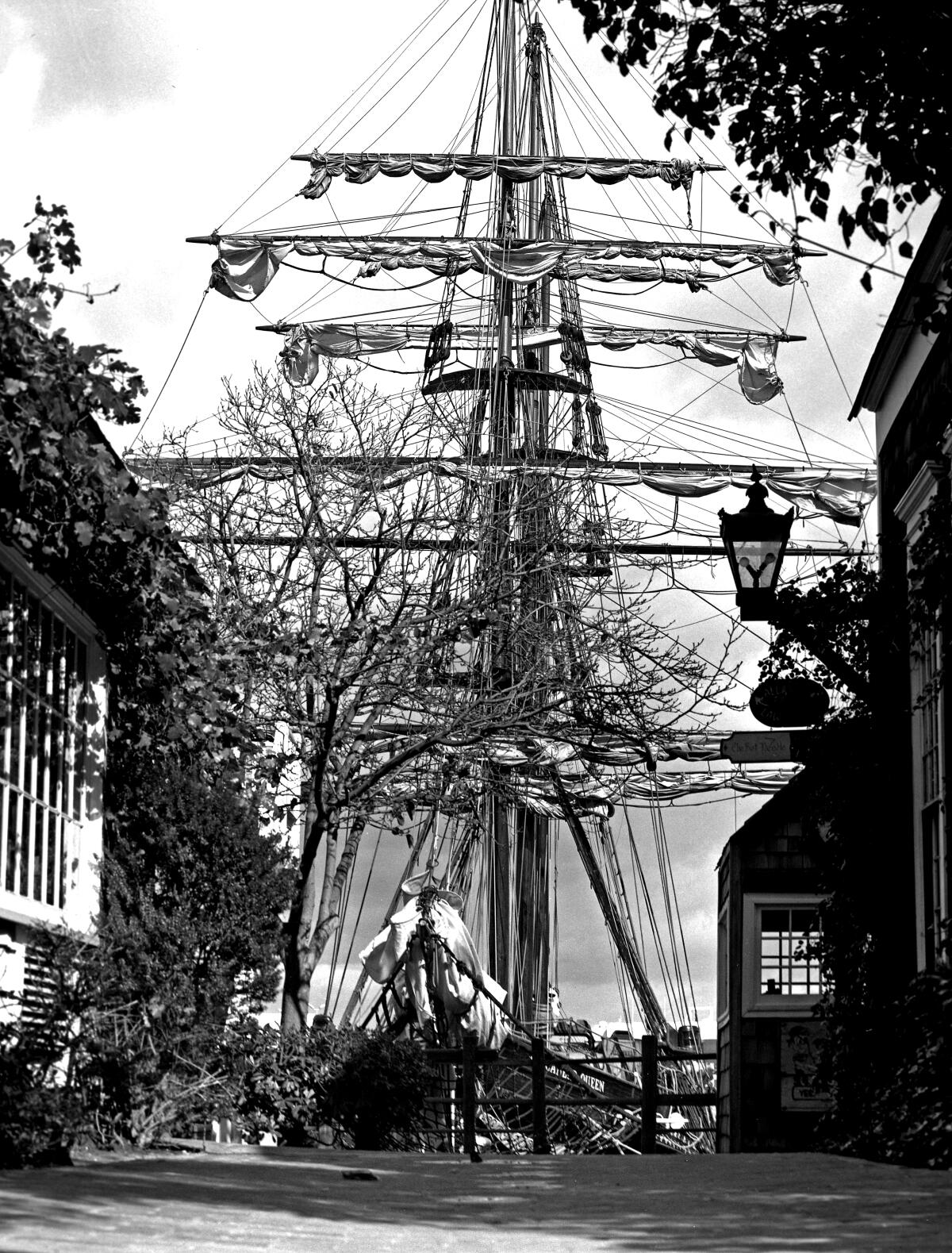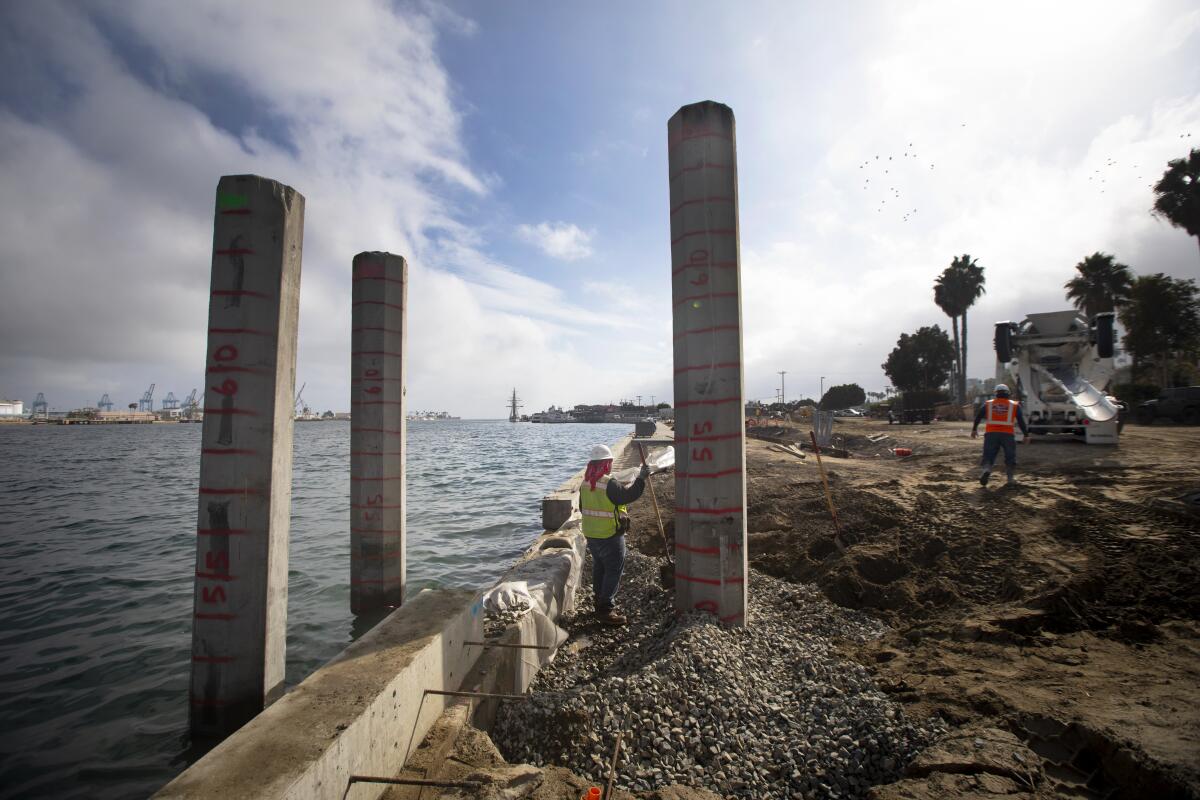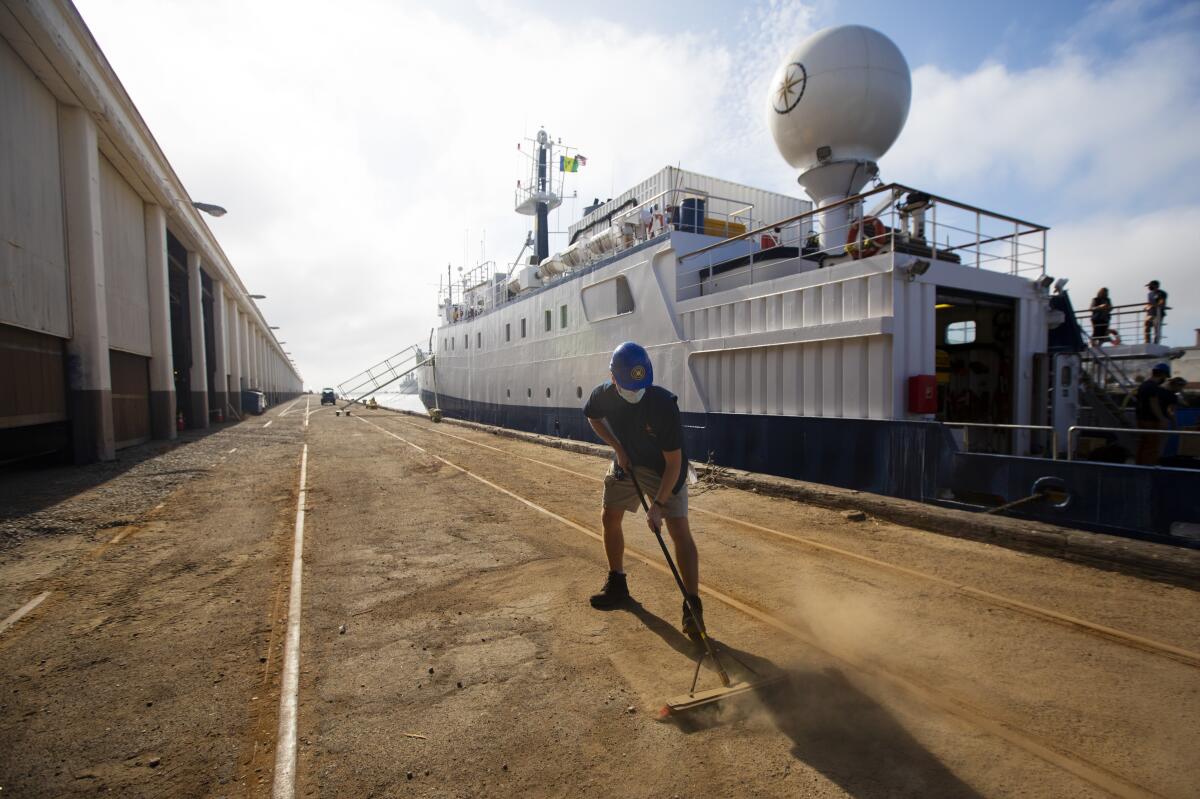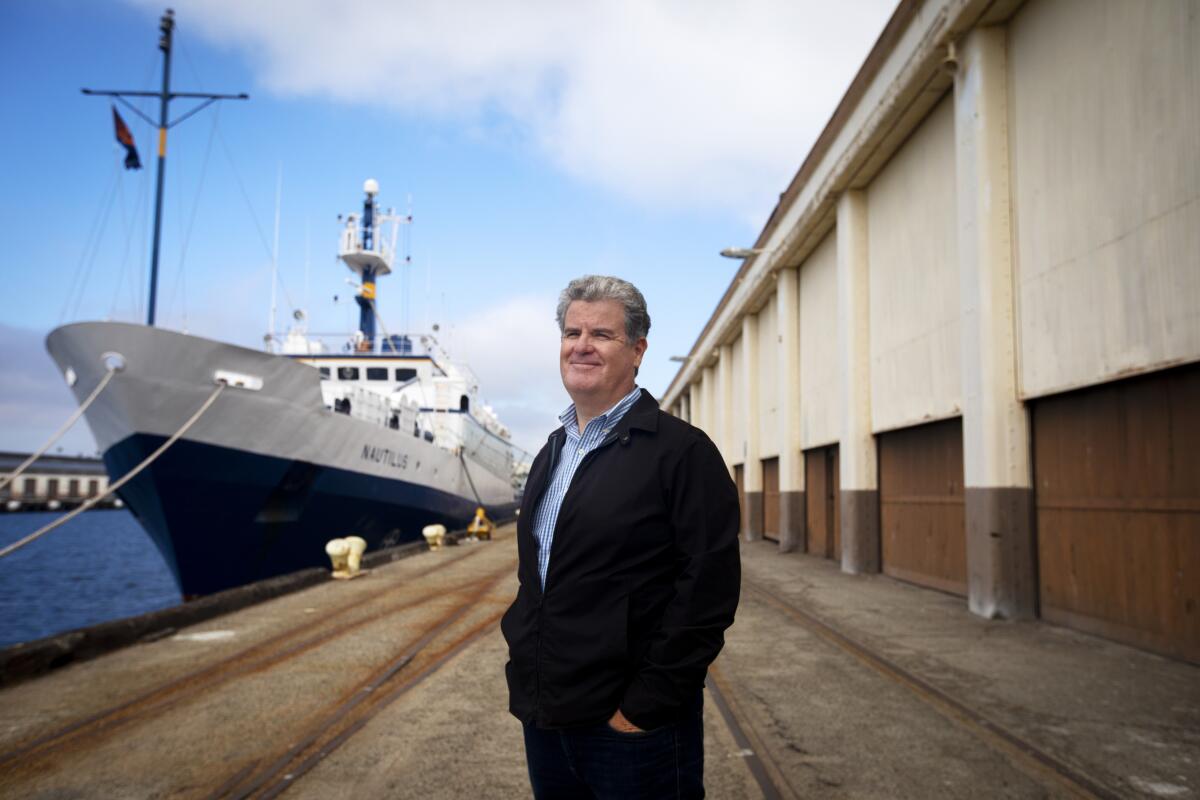San Pedro’s Ports O’ Call was torn down. A new waterfront is finally taking shape
- Share via
On the main channel of Los Angeles Harbor where the city’s shipping industry was born more than a century ago, a kitschy imitation of a New England fishing village called Ports O’ Call opened in 1962.

It was a major regional attraction where thousands came every year to stroll among quaint shops, take boat rides and dine by the water. For a period in the 1970s, the mast-like Skytower lifted visitors 30 stories high to show them giant tankers, cruise ships and fishing trawlers navigating the port.
But in the late 1980s, Ports O’ Call Village faded and grew shabby, a victim of changing tastes in entertainment and dwindling investment in its upkeep and improvement. Despite a last-minute, nostalgia-fueled community outcry and lawsuits from merchants and restaurants, all but the San Pedro Fish Market was demolished in 2018 to make way for dramatic redevelopment, first proposed by the Harbor Commission five years before.
Now the waterfront’s long-awaited makeover is finally taking shape.
One project will transform the former tourist magnet into a new seaside attraction with shops, restaurants and bars in shipping containers. In another, the city’s nearby original pier dating to the early 1900s is being converted to a sprawling center for new eco-friendly businesses building the ocean’s “blue economy.”
Among the new developments coming to the port is an amphitheater the size of L.A.’s Greek Theatre, where concerts will be heard a stone’s throw from a World War II-era battleship. Visitors will stroll a waterfront promenade designed by the architects of the High Line, Manhattan’s instant landmark park made out of a former elevated rail spur.
The multiple projects are part of a two-decade process to clean up the air and water at the port and turn unused docks, wharves and warehouses into a place where more people will want to work or visit for fun, port officials said.
“Bringing people to our waterfront has been a hallmark of the Port of Los Angeles for decades,” Executive Director Gene Seroka said, “and we believe that the investment in this particular project will really bring us to the next level.”
To smooth the path of new development catering to visitors, the Port of Los Angeles is investing about $1 billion in infrastructure improvements over 10 years, he said. Private developers building West Harbor, AltaSea and other projects will invest an estimated $500 million, said Michael Galvin, director of the port’s real estate operations.

“This is a once-in-a-lifetime opportunity,” Galvin said, “to really change these communities.”
At the Ports O’ Call site, expect to find a seaside brewery and beer garden among the spread of stores and restaurants in a 42-acre retail center called West Harbor that will have five times as much outdoor space as the Grove mall in Los Angeles.
Rising nearby will be a solar-powered “lighthouse” as tall as the Statue of Liberty, towering over a cluster of century-old warehouses containing new-economy businesses such as the headquarters of undersea explorer Robert Ballard, who located the wreck of the Titanic and the German battleship Bismarck. His research vessel the Nautilus docks there, as does Boeing’s prototype unmanned research submarine Echo Voyager.
Before the pandemic, about 3 million people came to the waterfront each year for recreation, a tally port leaders hope to double after people begin to venture out again.
West Harbor
A 2020 groundbreaking was delayed by the pandemic, but next year construction is set to begin on the $150-million first phase of West Harbor, the dining, shopping and entertainment complex that will replace Ports O’ Call. The project recently got a name change, from San Pedro Public Market, as it previously was known.
Dispensing with the old center’s improbable mix of New England, Spanish Colonial and Asian themes, West Harbor will evoke the industrial nature of the port with warehouse-style buildings filled with restaurants, bars and shops.
The layout was conceived by James Corner Field Operations, the architects and urban designers behind the High Line and Tongva Park in Santa Monica. The central courtyard will be flanked by repurposed shipping containers turned into small restaurant kitchens, seating, fire pits and a stage for live music and dancing.
There will be native plant gardens and family activities such as children’s playgrounds and bocce ball courts. For people arriving by water, there will be courtesy slips for private boats and water taxis.
One of the first restaurateurs to sign a lease was John Sangmeister, owner of Gladstone’s seafood restaurant in Long Beach, a competitive sailor who is also known for arranging public parties and stunts including a 2010 contest in which entrants made human-powered flying machines and piloted them off a 30-foot-high deck into the local harbor.
Sangmeister broke three ribs attempting to fly his own entry, but said he is game for more antics in San Pedro, where he plans another Gladstone’s. “We think this project lends itself to bigger, funner events and we’re excited to be a part of that.”
West Harbor is projected to open in 2022 but will continue to be developed in the years to follow and is intended to include a hotel after the travel business recovers from the pandemic. One of the recreational proposals being considered would bring a skate park, a wave machine for surfing and an artificial ski slope.
One proposed attraction that would combine alcohol with a sense of danger is what developer Eric Johnson calls an “aerobar.” It would be a tall open cylinder, reminiscent of the Skytower, where riders would sit in a circle with their feet dangling and be hoisted high enough to see to Catalina Island while being served cocktails by a bartender perched in the middle.
Johnson, whose San Pedro company Jerico Development is building West Harbor with Los Angeles developer Ratkovich Co., rode his bicycle to Ports O’ Call as a boy and hopes to recapture the enthusiasm the attraction generated in its heyday, when crowds were constant.
“It was locals on weekdays and locals and tourists on the weekends,” said Johnson, who was partial to the joke shop, glassblower and game arcade.
One of the key attractions for more modern tastes will be the amphitheater, a 6,200-seat venue operated by Los Angeles music promoter Nederlander Concerts.
The region has several concert halls, but there is room for another, Chief Executive Alex Hodges said, at least in that unusual location for live shows.
“We love the idea of being at the waterfront,” he said. “It’s just a thrill — the bridges are landmarks. They speak to a big, exciting, mysterious world” of international commerce.

Hodges envisions people looking down on shows from the deck of the USS Iowa, a retired battleship launched in 1942 that is berthed a mile up the Main Channel where it serves as a naval museum. Plans call for moving the Iowa to a slip next to West Harbor, no small feat considering it is a 45,000-ton vessel once known as the “Big Stick.”
“It’s going to be a challenge” to transport, Seroka said, a costly task requiring extensive engineering work and dredging of the channel. “But believe me, this community can do it.”
After a competition among developers, port leaders selected Jerico Development and Ratkovich Co. to build the replacement to Ports O’ Call and signed them to a 66-year lease on the property.
Ratkovich Co. President Wayne Ratkovich said he hopes West Harbor will be a boon for San Pedro, “a city within a city that has often been overlooked” as a neighborhood of Los Angeles. “We saw an opportunity to re-energize a unique downtown.”
AltaSea
In the early 20th century, Los Angeles merchants and city leaders set out to capture a share of the increased global shipping trade expected to pass through the Panama Canal, a link between the Atlantic and Pacific oceans that opened in 1914. They created a municipal wharf with a long stretch of warehouses where ships were loaded and unloaded into trains, carts and trucks by burly longshoremen.
The growth of containerized shipping after World War II gradually rendered City Dock No. 1 obsolete for moving goods but left behind a choice 35-acre site for a complex of pioneering tech companies focused on sustainable uses of the world’s oceans.

AltaSea is in its early stages but so far rents space to eco-friendly start-ups, including one that raises edible mussels far out at sea, creating a sustainable food source. A company spun off from Caltech and the Jet Propulsion Laboratory in La Cañada Flintridge can locate objects deep underwater such as lost vessels, and map the depths of the ocean. Another fledgling business creates high-tech coral farms and uses remotely operated submarines to distribute baby corals onto threatened reefs.
Part of AltaSea’s mission is to create jobs that didn’t previously exist, said Chief Executive Tim McOsker, who grew up in San Pedro when work was plentiful on the docks or for the fleet of fishermen based there.
“We are looking at a future where, without some intervention, it may not be possible to sustain the kind of middle-class incomes that families had growing up here” for generations, he said. “We have the opportunity to expand the blue economy here in the harbor area and create a future for our kids.”
The figurative whale for AltaSea so far is Ballard, who has captured public interest as a deep-sea explorer and scientific researcher. His 211-foot research vessel is based there and he plans to build an educational visitors’ center called the Bob Ballard Experience inside a 1920s industrial building that is also his headquarters and home to his research and development.
“Bob Ballard is somebody who attracts other businesses,” McOsker said. “We all want to be close to Bob because of his credibility.”
That includes leaders of 23 institutions and universities, including USC and UCLA, that are part of the Southern California Marine Institute, which trains students in ocean studies and entrepreneurship in the emerging blue economy. The institute plans to move in 2023 from a small facility on Terminal Island to larger quarters in the same former warehouse Ballard occupies.
AltaSea is planning a 180,000-square-foot array of solar panels on the roof of one warehouse to provide power to the businesses inside. A more symbolic solar-powered “lighthouse” will be built as part of a new engagement center for visitors at the north edge of the water.
“We wanted to create a beacon for the port so that everyone could recognize where AltaSea is from a long distance away, “ said Andy Cohen, co-chief executive of Gensler, the architecture firm overseeing the design of the 35-acre campus.
The exterior of the 14-story tower will light up with energy drawn from the sun, and visitors who climb stairs to the top can take in the industrial theater of the modern port and the renovated historical City Dock No. 1.
“We are going to mesh old industrial buildings, where horses and buggies picked up arrivals, with a modern science campus,” Cohen said. “This is about the future of the planet, and for generations to come.”
More key projects
West Harbor and AltaSea aren’t the only recreational improvements coming to the port.
Port officials broke ground in October on the $71-million Wilmington Waterfront Promenade. The nine-acre development will provide more direct public access to Wilmington’s historic waterfront and create more open spaces and recreational areas for the harbor community’s residents. The project will include a park and a public pier and dock.
Work is also underway on the $33-million Town Square and waterfront promenade project that will connect West Harbor with a historic seaside landmark: the Streamline Moderne-style San Pedro Municipal Ferry Building.
Built in 1941, it was the terminal for ferries that connected the mainland with Terminal Island before the Vincent Thomas Bridge was completed in 1963.
Now housing the Los Angeles Maritime Museum, the square will serve as the pedestrian connecting point between downtown San Pedro and West Harbor.
More to Read
Inside the business of entertainment
The Wide Shot brings you news, analysis and insights on everything from streaming wars to production — and what it all means for the future.
You may occasionally receive promotional content from the Los Angeles Times.











